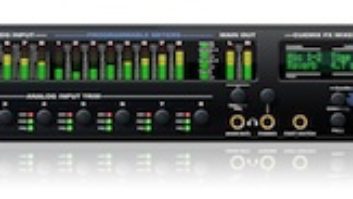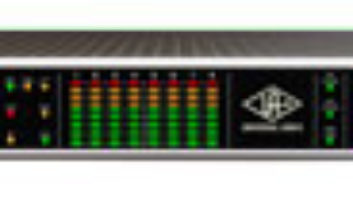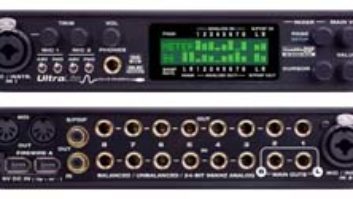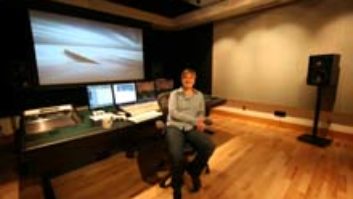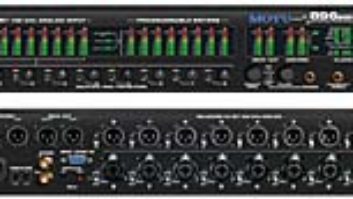FireWire interfaces are wonderful tools because they are easier to install than a PCI card-based I/O. However, the fact that you can get more I/O from a PCI card-based breakout box does not mean that FireWire interfaces are right for every setup. MOTU broke significant new ground with the 828, but with only eight ins and outs and missing key pro features (like comprehensive front panel meters, AES/EBU, wordclock and mic pre’s on every input), it’s essentially a home-studio interface. But the MOTU design team is clearly not content to rest on its laurels: A few months back, MOTU introduced the 896. This new interface targets audio professionals’ needs, adding all of the above-mentioned features and much more.
The 896 is a solid-feeling, two-space rack unit that supports sample rates up to 96 kHz and 24 bits. Equipped with ADAT Optical and AES/EBU digital I/O, as well as eight channels of analog I/O, it can support 18 channels in and out running simultaneously at 44.1 or 48 kHz. (At high sample rates, ADAT Optical is disabled.) If this isn’t enough I/O for you, the 896’s second onboard FireWire port can daisy-chain up to four units. (MOTU reports that a single FireWire bus can handle 72 channels of audio running simultaneously.) Still not enough I/O? You can always add a PCI expansion card with a second FireWire bus for another chain of 896s.
Inputs are Neutrik Combo connectors, which makes connecting XLR or ¼-inch jacks a snap. Each input is switchable between +4 or -10 dB via dip switches on the unit’s rear panel. Toggle switches for phantom power on/off on each input are found on the unit’s face, as are individual channel-trim controls. The analog outputs are all balanced XLR, including the main stereo out whose source is a mix of analog outs 1-2 and any live CueMix inputs. (I’ll explain this feature later.) The main out shares a level knob with the headphone jack on the front panel.
MOTU has developed a zero-latency monitoring system dubbed CueMix, which solves the inherent problem of monitoring latency when recording tracks into a computer. The idea behind CueMix is that the signal routing to input-monitor one mono or stereo input is done entirely within the 896. CueMix lets you bus any input or input pair directly to the main outs (via the 896 itself, bypassing the computer). A dedicated Level knob on the front panel lets you control the CueMix volume relative to the rest of the main out mix. Because the user is not input-monitoring through the computer, monitoring latency is sidestepped. The downside to this scheme is that you can’t monitor input with your digital audio program’s internal effects. (How about putting a stereo send/return exclusively for input-monitoring onboard the 896?) If you don’t have a console and you must input-monitor more than two channels with effects, then lower your host program’s audio buffers to provide lower-latency input-monitoring at the cost of higher CPU usage.
Metering on the 896 is well-implemented. All of the LED meters are a 10-segment type with easy-to-see peak and clip-hold indicators. (Hold times for both indicators are user-definable.) The clip-hold LED illuminates at a single sample over 0 dB. There are eight meters dedicated to the analog inputs, while another eight meters show either the analog outs or ADAT Optical inputs or outputs. A stereo pair of meters reflects the main out, and another pair will display either AES/EBU input or output.
Other amenities include Word Clock In and Out, ADAT Sync In (a wonderful feature that is happily continued on MOTU’s interfaces), and a front panel footswitch jack to enable hands-free punching. The AES/EBU I/O can sample rate-convert on input or output — a convenient feature, especially when your project is at 96 kHz. Power is supplied by a detachable IEC Type-II power cable, and a rocker-style power switch is located on the unit’s face.
The 896 works with a Mac running OS 8.6 or later, or a PC running Windows ME/2000/XP. (Although Mac OS X was not supported at the time of this field test, it should be supported when you read this.) ASIO drivers for Mac and PC are included, as are WDM drivers for PC. Even if you don’t own multitrack digital audio software, MOTU’s Audio-Desk application — a 24-bit/96kHz-capable recording program based on the audio portion of Digital Performer — comes standard. The catch is, AudioDesk is Mac-only. A 1394 FireWire cable that has a high-quality feel and is plenty long (12 feet to be exact — interfaces with really short stock cables can be a pain to set up) is also included.
I field-tested the 896 with a Mac G4 400MHz machine running OS 9.2.2. The digital audio sequencers I employed were Emagic’s Logic Audio Platinum 5.2 and Digital Performer 3.0.2. Physically hooking the unit up is super-easy: Plug in the FireWire cable and that’s it. Installing MOTU’s FireWire Audio system extensions, control panel and ASIO driver from the included CD-ROM was a breeze. Only Logic Audio required the ASIO driver, because Digital Performer is also a MOTU product and addresses the MOTU FireWire interfaces directly.
All settings (such as clock source, AES/EBU sample-rate conversion, and peak and clip-hold times) for the 896 are made in the MOTU FireWire Audio control panel, which is the same one used for the 828. If you upgrade from the 828 to the 896, and you already have Version 2.1 of the control panel installed, you should be able to connect the 896 without touching the CD-ROM. However, remember to select the 896 as your new interface and assign it a proper clock source in the control panel because this is not automatic. (The 896 will actually operate with the 828 interface and 828 internal clock source selected, even though the 828 is not connected.)
The 896 worked fine with Logic Audio and Digital Performer. Admittedly, it felt slightly better-integrated with Digital Performer. For example, your CueMix monitor input is automatically selected when you record-arm a track in Digital Performer. In Logic Audio, as with all programs dependent on the ASIO driver, you must manually select the inputs you want to feed CueMix from the MOTU FireWire Audio control panel. For both programs, input-monitor latency (sans CueMix) with a Samples Per Buffer setting of 256k in the control panel was low enough to be acceptable in many situations.
The 896’s sound quality is solid, with a clean, clear character that is very nice. I recorded acoustic guitar, voice and percussion parts and was pleased with the results. I could complain that it doesn’t sound as good as Digidesign’s 192 I/O with its built-in soft-clip limiters, but this would be a ridiculous comparison because the 896 retails for about a quarter of the price of the 192 I/O; MSRP for the 896 is $1,295. If you use Digital Performer and a laptop, this is hands-down the pro audio interface to have. Even if you work with a different digital audio application and have only a desktop computer, the 896 is an audio interface that you should seriously consider (particularly, if installing PCI cards isn’t your cup of tea).
MOTU, 1280 Massachusetts Ave., Cambridge, MA 02138; 617/576-2760; fax 617/576-3609; www.motu.com.
Visit Erik Hawkins’ indie label atwww.muzicali.comand check out his best-selling virtual studio-recording book, Studio-In-a-Box (Artistpro/Hal Leonard).
